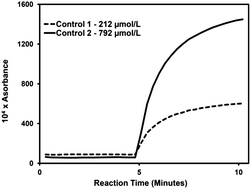An improved enzymatic assay for glycated serum protein
Abstract
Recent studies have shown that blood HbA1c levels alone may not accurately reflect serum

* Corresponding authors
a
Diazyme Laboratories, 12889 Gregg Court, Poway, USA
E-mail:
chong.yuan@diazyme.com
Tel: +1 858-455-4760
Recent studies have shown that blood HbA1c levels alone may not accurately reflect serum

 Please wait while we load your content...
Something went wrong. Try again?
Please wait while we load your content...
Something went wrong. Try again?
D. Abidin, L. Liu, C. Dou, A. Datta and C. Yuan, Anal. Methods, 2013, 5, 2461 DOI: 10.1039/C3AY40165K
To request permission to reproduce material from this article, please go to the Copyright Clearance Center request page.
If you are an author contributing to an RSC publication, you do not need to request permission provided correct acknowledgement is given.
If you are the author of this article, you do not need to request permission to reproduce figures and diagrams provided correct acknowledgement is given. If you want to reproduce the whole article in a third-party publication (excluding your thesis/dissertation for which permission is not required) please go to the Copyright Clearance Center request page.
Read more about how to correctly acknowledge RSC content.
 Fetching data from CrossRef.
Fetching data from CrossRef.
This may take some time to load.
Loading related content
